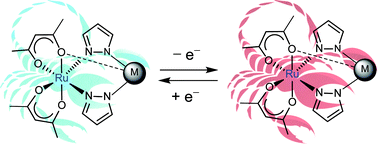Bis(acetylacetonato)bis(pyrazolato)ruthenate(iii) as a redox-active scorpionate ligand†
Abstract
The potential of a new anionic octahedral metal complex [RuIII(acac)2(pz)2]− (1−) (pzH = pyrazole) as a ligand with a scorpionate coordination behaviour like tris(pyrazolyl)borate (tp) and reversible redox activity is presented. Trinuclear metal complexes, [RuIII2ZnII(acac)4(pz)4] (2) and [RuIIRuIII2(acac)4(pz)4] (3), were each synthesized by the reaction of ZnCl2 or Ru3(CO)12 with [RuIII(acac)2(pz)(pzH)] (1H) that is in situ deprotonated and acts as a precursor of 1−. Single-crystal X-ray diffraction studies clarified that 1− acts as a scorpionate ligand; two 1− units in 2 and one unit in 3 function as bidentate ligands with two pyrazolates as pincers, while another 1− unit in 3 functions as a tridentate ligand with one oxygen atom as a tail in addition to the two pyrazolate pincers. Moreover, 2 and 3 showed reversible multi-stage redox behaviours based on the RuII/RuIII and RuIII/RuIV couples of the 1− units in the cyclic voltammetry (CV) measurements. Based on the X-ray, IR, and CV measurements and the comparison with other Ru(II) complexes with tp derivatives, the 1− unit was found to act as a redox-active scorpionate with electron withdrawing properties compared to the tp.


 Please wait while we load your content...
Please wait while we load your content...